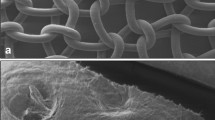Abstract
Two types of monofilament polypropylene mesh with different pore sizes, mass densities and burst strengths were used to repair two identical paired full-thickness abdominal wall defects in ten dogs, in order to compare their integration histology 90 days after implantation. On one side a standard mesh, Prolene® (Ethicon), was sutured to the borders of the defect, while on the other a new ultralightweight macroporous mesh, Mpathy® mesh, was used. There was a significantly greater densitometric proportion of mature (type I) collagen (58.38%) for Mpathy® mesh compared to Prolene® (34.05%, P = 0.01). Although Prolene® has 3.6 times the burst strength of Mpathy® mesh, the implanted tissue strength was marginally greater for Mpathy® mesh. We conclude that Mpathy® mesh gives a surgical repair that is at least as strong as that provided by Prolene®, along with a higher concentration of mature collagen and less fibrosis (P = 0.07), in this canine histology model.
Similar content being viewed by others
References
Klinge U, Klosterhalfen B, Müller M, Schumpelick VI (1999) Forein body reaction to meshes used for the repair of abdominal wall hernias. Eur J Surg 165:665–673
Marois Y, Cadi R, Gourdon J, Fatouraee N, King MW, Zhang Z, Guidolin R (2000) Biostability, inflammatory response, and healing characteristics fluoropasssivated polyester-knit mesh in the repair of experimental abdominal hernias. Artif Organs 24:533–543
Greca FH, Biondo-Simões MLP, Paula JB, Costa FD, Silva APG, Time S, Mansur A (2001) The Influence of differing pore sizes on the biocompatibility of two polypropylene meshes in the repair of abdominal defects: experimental study in dogs. Hernia 5:59–64
Klinge U, Schumpelick V, Klosterhalfen B (2001) Functional assessment and tissue response of short and long term absorbable surgical meshes. Biomaterials 22:1415–1424
Klosterhalfen B Klinge U, Schumpelick V (1998) Functional and morphological evaluation of different polypropylene-mesh modifications for abdominal wall repair. Biomaterials 19:2235–2246
Abhay S, Pandit AS, Jerome AH (2004) Design of surgical meshes: an engineering perspective. Technol Health Care 12:51–65
Vavrik J, Foltynova V, Vitkova I, Adamek S, Pouckova P (2000) Changes in abdominal wall after mesh implantation in rats. Med Sci Monit 6:476–479
Klinge U, Klosterhalfen B, Ottinger AP, Junge K, Schumpelick V (2002) PVDF as a new polymer for the construction of surgical meshes. Biomaterials 23:3487–3493
Pandot AS, Henry JA (2004) Design of surgical meshes—an engineering perspective. Technol Health Care 12:51–65
Cassar K, Munro A (2002) Surgical treatment of incisional hernia. Br J Surg 89:534–545
Bellon JM, Bujan J, Contreras LA, Carrera SM, Jurado F (1996) Comparison of a new type of polytetrafluoroethylene patch (Mycro mesh) and polypropylene prosthesis (Marlex) for repair of abdominal wall defects. J Am Coll Surg 183:11–18
Bauer JJ, Harris MT, Kreel I, Gelernt I (1999) Twelve-year experience with expanded polytetrafluoroethylene in the repair of abdominal wall defects. Mt Sinai J Med 66:20–25
Besim H, Yalçn Y, Hamamc O, Arslan K, Sonk M, Korkmaz A, Erdoan S (2002) Prevention of intraabdominal adhesions produced by polypropylene mesh. Eur Surg Res 34:239–243
Klinge U, Junge K, Stumpf M, Ottinger A, Klosterhalfen B (2002) Functional and morphological evaluation of a low-weight, monofilament polypropylene mesh for hernia repair. J Biomed Mater Res 63:129–136
Junqueira LCU, Cossermelli W, Bretani RR (1978) Differential staining of collagen type I, II and III by Sirius red and polarization microscopy. Arch Histol Jpn 41:267–74
Klinge U, Conze J, Limberg W, Brucker C, Ottinger AP, Schumpelick V (1996) Pathophysiology of the abdominal wall. Chirurg 67:229–233
Bouillot JL, Servajean S, Berger N, Veyrie N, Hugol D (2004) Comment choisir une prothèse pour le traitement des éventrations abdominals? Ann Chir 129:132–137
Borrazo EC, Belmont MF, Boffa D, Fowler DL (2004) Effect of prosthetic material on adhesion formation after laparoscopic ventral hernia repair in a porcine model. Hernia 8:108–112
Merritt K, Shaffer JW, Brown SA (1979) Implant-site infection rates with porous and dense material. J Biomed Mater Res 13:101–108
Pourdeyhimi B (1989) Porosity of surgical mesh fabrics: new technology. J Biomed Mater Res 23:145–152
Junge K, Klinge U, Rosh R, Mertens PR, Kirch J, Klosterhalfen B, Lynen P, Schumpelick V (2004) Decreased collagen type I/III ratio in patients with recurring hernia after implantation of alloplastic prostheses. Langenbecks Arch Surg 389:17–22
Author information
Authors and Affiliations
Corresponding author
Rights and permissions
About this article
Cite this article
Greca, F.H., Souza-Filho, Z.A., Giovanini, A. et al. The influence of porosity on the integration histology of two polypropylene meshes for the treatment of abdominal wall defects in dogs. Hernia 12, 45–49 (2008). https://doi.org/10.1007/s10029-007-0276-6
Received:
Accepted:
Published:
Issue Date:
DOI: https://doi.org/10.1007/s10029-007-0276-6




